5 Reasons why it's a bad idea to feed waterfowl
Thinking back to my childhood, I have very fond memories of visiting my mother’s family in New York and bringing a bag of stale bread crumbs to the local “watering holes” to feed the numerous ducks. This was a treat for my siblings and me since we didn’t see ducks often. I don’t ever remember seeing signs that warned against feeding the wildlife (though these signs tend to be invisible to kids unless pointed out).
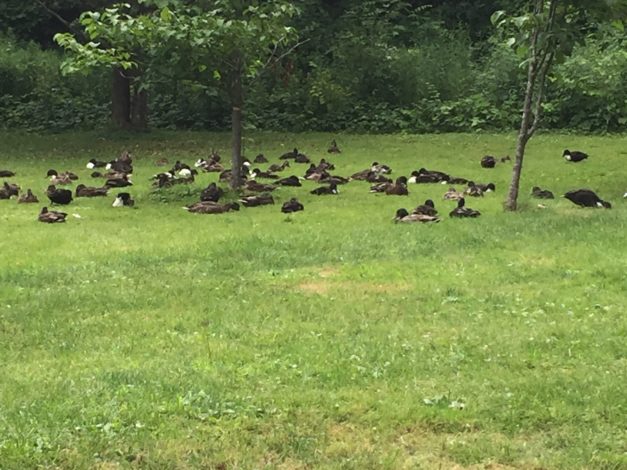 3. Spread of disease
Have you ever noticed that visiting a park with a population of duck and geese usually involves dodging their droppings as you walk? My toddler calls this “dodging the quack poo.” Those droppings are generally in the same area where breadcrumbs (and other leftovers) are scattered for the birds. This can quickly spread diseases like Duck Virus Enteritis among the waterfowl, especially in overcrowded areas. In addition, when an excess of food is distributed, any uneaten food can pile up and turn moldy. This can lead to diseases like Aspergillus, which can be fatal to waterfowl.
4. Water pollution
On a recent trip to Lake George, NY, I noticed a sign that stated “Do Not Feed the Ducks, We Drink This Water.” That definitely caught my attention, so I checked out their website in search of an explanation. According to their site, duck droppings contain higher levels of phosphorus, which is usually only found in low-concentrations in the lake. When phosphorus levels increase due to overpopulation, it can result in algal blooms. This reduces the oxygen level of the lake and begins to kill off other plants and animals. In addition, an increase in waterfowl feces in the lake decreases the water quality for the residents and businesses that rely on the lake as a water source (not to mention the thousands of people who swim in the lake every summer).
3. Spread of disease
Have you ever noticed that visiting a park with a population of duck and geese usually involves dodging their droppings as you walk? My toddler calls this “dodging the quack poo.” Those droppings are generally in the same area where breadcrumbs (and other leftovers) are scattered for the birds. This can quickly spread diseases like Duck Virus Enteritis among the waterfowl, especially in overcrowded areas. In addition, when an excess of food is distributed, any uneaten food can pile up and turn moldy. This can lead to diseases like Aspergillus, which can be fatal to waterfowl.
4. Water pollution
On a recent trip to Lake George, NY, I noticed a sign that stated “Do Not Feed the Ducks, We Drink This Water.” That definitely caught my attention, so I checked out their website in search of an explanation. According to their site, duck droppings contain higher levels of phosphorus, which is usually only found in low-concentrations in the lake. When phosphorus levels increase due to overpopulation, it can result in algal blooms. This reduces the oxygen level of the lake and begins to kill off other plants and animals. In addition, an increase in waterfowl feces in the lake decreases the water quality for the residents and businesses that rely on the lake as a water source (not to mention the thousands of people who swim in the lake every summer).
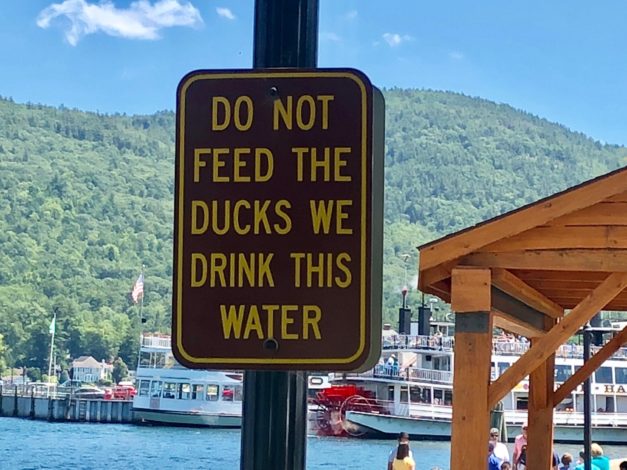 5. Delayed migration
It is common knowledge that ducks migrate south for the winter in search of a warmer climate where natural food sources are more plentiful. However, ducks may be reluctant to leave when they have a guaranteed food source in the form of human handouts. This can be detrimental as some may not survive a sudden onset of frigid fall and winter temperatures (not to mention the fact that most people aren’t willing to scatter breadcrumbs in a blizzard).
5. Delayed migration
It is common knowledge that ducks migrate south for the winter in search of a warmer climate where natural food sources are more plentiful. However, ducks may be reluctant to leave when they have a guaranteed food source in the form of human handouts. This can be detrimental as some may not survive a sudden onset of frigid fall and winter temperatures (not to mention the fact that most people aren’t willing to scatter breadcrumbs in a blizzard).
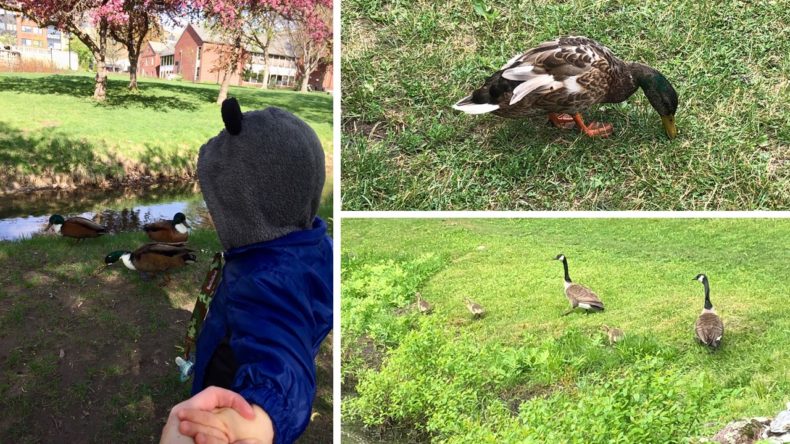 2. Identify the bird: Whether you purchase a bird guide for your area or simply look it up on your smart phone, identifying a waterfowl species can give you insight into their habits in the wild. You can also find posters and information at many local parks that have bird-watching areas.
3. Observe duck habits in their environment: One of my favorite family outings is to enjoy a picnic near one of the local duck ponds in our area. Once the ducks realize they won’t be getting handouts, they ignore us for the most part. This gives us an opportunity to observe the ducks and their natural habits and routines (or as “natural” as they can get in a less-then-wild environment). My son’s favorite “duck habit” is when they dive their head into the water and stick their backside up in the air. It never fails to send him into a giggling fit! I have started to ask him questions like “why do you think they do that?” He’s still a bit young to answer, but I'll give him my guesses and he usually humors me by nodding and saying “yeah!” Below are some questions that can help your family start conversations about waterfowl habits. No need to know the answers because looking them up is half the fun! Here is a website I've used to find some fun facts about ducks.
2. Identify the bird: Whether you purchase a bird guide for your area or simply look it up on your smart phone, identifying a waterfowl species can give you insight into their habits in the wild. You can also find posters and information at many local parks that have bird-watching areas.
3. Observe duck habits in their environment: One of my favorite family outings is to enjoy a picnic near one of the local duck ponds in our area. Once the ducks realize they won’t be getting handouts, they ignore us for the most part. This gives us an opportunity to observe the ducks and their natural habits and routines (or as “natural” as they can get in a less-then-wild environment). My son’s favorite “duck habit” is when they dive their head into the water and stick their backside up in the air. It never fails to send him into a giggling fit! I have started to ask him questions like “why do you think they do that?” He’s still a bit young to answer, but I'll give him my guesses and he usually humors me by nodding and saying “yeah!” Below are some questions that can help your family start conversations about waterfowl habits. No need to know the answers because looking them up is half the fun! Here is a website I've used to find some fun facts about ducks.
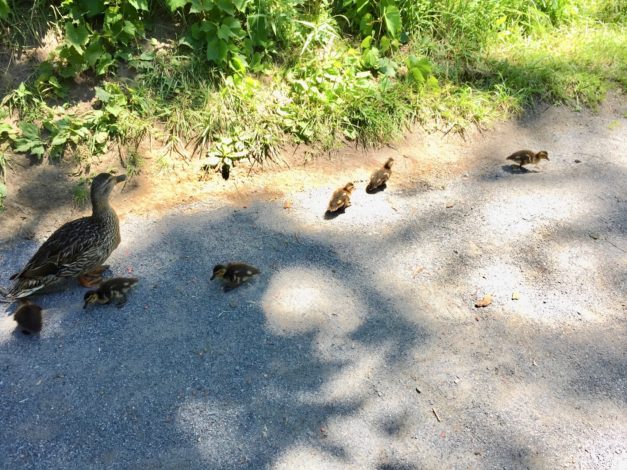 Does your family have any fun ways to enjoy the waterfowl without feeding them? Let us know in the comments below.
Photos by Rebecca Hosley.
Does your family have any fun ways to enjoy the waterfowl without feeding them? Let us know in the comments below.
Photos by Rebecca Hosley.
Is feeding waterfowl really bad?
Nowadays, every pond and lake I visit boasts signs that ask visitors to not feed the ducks or wildlife. The cautions and explanations on these signs tend to differ, but they are present nonetheless. Having a somewhat scientific, ever-curious mind, my first thought was “Oh yeah? Show me the evidence!” Is it really that bad to throw some old bread crumbs out for a few ducks to enjoy? It turns out these sign-makers and park officials are on to something. Below is a list of common cautions explanation and evidence that are important for us to heed their warnings. 1. Nutrient deficiencies It used to be that any time I would think of ducks, breadcrumbs also came to mind. They just go together, right? That’s why when I found out that bread is actually bad for ducks, I was shocked. It was equivalent to finding out that most cats are lactose intolerant … how is that even possible? Unfortunately, evidence now shows that bread is essentially a junk food for ducks, filling them up but providing little nutritional value. This can lead to malnutrition when ducks mainly consume bread and neglect to pursue other natural forms of nutrition. In extreme cases, this malnutrition can lead to further issues such as “angel wing” syndrome, an incurable wing deformity that can prevent birds from flying and threaten their survival. 2. Dependency on humans While there are other foods that won’t hurt the waterfowl (such as lettuce and oats), the issue of dependency arises when wildlife rely on food from unnatural sources. When ducks and geese are no longer wary of humans, they may become more aggressive to other animals and humans as they compete for handouts. Unnatural food sources can also cause overcrowding, which can then lead to environmental degradation due to overgrazing and badly eroded landscapes. For example, within a nearby townhome complex there are three ponds that numerous waterfowl call home. Unfortunately, due to the increasing bird numbers caused by unnatural feeding by residents, the areas surrounding the ponds are eroding. According to management, this has caused maintenance and clean-up costs to skyrocket. 3. Spread of disease
Have you ever noticed that visiting a park with a population of duck and geese usually involves dodging their droppings as you walk? My toddler calls this “dodging the quack poo.” Those droppings are generally in the same area where breadcrumbs (and other leftovers) are scattered for the birds. This can quickly spread diseases like Duck Virus Enteritis among the waterfowl, especially in overcrowded areas. In addition, when an excess of food is distributed, any uneaten food can pile up and turn moldy. This can lead to diseases like Aspergillus, which can be fatal to waterfowl.
4. Water pollution
On a recent trip to Lake George, NY, I noticed a sign that stated “Do Not Feed the Ducks, We Drink This Water.” That definitely caught my attention, so I checked out their website in search of an explanation. According to their site, duck droppings contain higher levels of phosphorus, which is usually only found in low-concentrations in the lake. When phosphorus levels increase due to overpopulation, it can result in algal blooms. This reduces the oxygen level of the lake and begins to kill off other plants and animals. In addition, an increase in waterfowl feces in the lake decreases the water quality for the residents and businesses that rely on the lake as a water source (not to mention the thousands of people who swim in the lake every summer).
3. Spread of disease
Have you ever noticed that visiting a park with a population of duck and geese usually involves dodging their droppings as you walk? My toddler calls this “dodging the quack poo.” Those droppings are generally in the same area where breadcrumbs (and other leftovers) are scattered for the birds. This can quickly spread diseases like Duck Virus Enteritis among the waterfowl, especially in overcrowded areas. In addition, when an excess of food is distributed, any uneaten food can pile up and turn moldy. This can lead to diseases like Aspergillus, which can be fatal to waterfowl.
4. Water pollution
On a recent trip to Lake George, NY, I noticed a sign that stated “Do Not Feed the Ducks, We Drink This Water.” That definitely caught my attention, so I checked out their website in search of an explanation. According to their site, duck droppings contain higher levels of phosphorus, which is usually only found in low-concentrations in the lake. When phosphorus levels increase due to overpopulation, it can result in algal blooms. This reduces the oxygen level of the lake and begins to kill off other plants and animals. In addition, an increase in waterfowl feces in the lake decreases the water quality for the residents and businesses that rely on the lake as a water source (not to mention the thousands of people who swim in the lake every summer).
 5. Delayed migration
It is common knowledge that ducks migrate south for the winter in search of a warmer climate where natural food sources are more plentiful. However, ducks may be reluctant to leave when they have a guaranteed food source in the form of human handouts. This can be detrimental as some may not survive a sudden onset of frigid fall and winter temperatures (not to mention the fact that most people aren’t willing to scatter breadcrumbs in a blizzard).
5. Delayed migration
It is common knowledge that ducks migrate south for the winter in search of a warmer climate where natural food sources are more plentiful. However, ducks may be reluctant to leave when they have a guaranteed food source in the form of human handouts. This can be detrimental as some may not survive a sudden onset of frigid fall and winter temperatures (not to mention the fact that most people aren’t willing to scatter breadcrumbs in a blizzard).
How can I enjoy ducks without feeding them?
While this may come as disheartening news, fear not! We can still enjoy the ducks in ways that are safe for them and the environment! Following are a few examples of ways to appreciate our water-loving feathered friends that the kids will love. 1. Take a photo or draw a picture: My toddler loves “helping” me take photos of the ducks and geese, and I love taking photos of him admiring them. You can look back at the photos later to remember the time spent together watching the wildlife. Looking for a technology-free option? Have your kiddos (and yourself!) draw a picture of the birds in their habitat. 2. Identify the bird: Whether you purchase a bird guide for your area or simply look it up on your smart phone, identifying a waterfowl species can give you insight into their habits in the wild. You can also find posters and information at many local parks that have bird-watching areas.
3. Observe duck habits in their environment: One of my favorite family outings is to enjoy a picnic near one of the local duck ponds in our area. Once the ducks realize they won’t be getting handouts, they ignore us for the most part. This gives us an opportunity to observe the ducks and their natural habits and routines (or as “natural” as they can get in a less-then-wild environment). My son’s favorite “duck habit” is when they dive their head into the water and stick their backside up in the air. It never fails to send him into a giggling fit! I have started to ask him questions like “why do you think they do that?” He’s still a bit young to answer, but I'll give him my guesses and he usually humors me by nodding and saying “yeah!” Below are some questions that can help your family start conversations about waterfowl habits. No need to know the answers because looking them up is half the fun! Here is a website I've used to find some fun facts about ducks.
2. Identify the bird: Whether you purchase a bird guide for your area or simply look it up on your smart phone, identifying a waterfowl species can give you insight into their habits in the wild. You can also find posters and information at many local parks that have bird-watching areas.
3. Observe duck habits in their environment: One of my favorite family outings is to enjoy a picnic near one of the local duck ponds in our area. Once the ducks realize they won’t be getting handouts, they ignore us for the most part. This gives us an opportunity to observe the ducks and their natural habits and routines (or as “natural” as they can get in a less-then-wild environment). My son’s favorite “duck habit” is when they dive their head into the water and stick their backside up in the air. It never fails to send him into a giggling fit! I have started to ask him questions like “why do you think they do that?” He’s still a bit young to answer, but I'll give him my guesses and he usually humors me by nodding and saying “yeah!” Below are some questions that can help your family start conversations about waterfowl habits. No need to know the answers because looking them up is half the fun! Here is a website I've used to find some fun facts about ducks.
- What do you think they eat?
- How do they find their food?
- Why do you think they “escape” to the water when humans or other animals get too close?
- When do you think baby ducks learn to fly?
- Why do you think ducks “bite” their feathers?
- What differences do you notice between ducks and geese?
 Does your family have any fun ways to enjoy the waterfowl without feeding them? Let us know in the comments below.
Photos by Rebecca Hosley.
Does your family have any fun ways to enjoy the waterfowl without feeding them? Let us know in the comments below.
Photos by Rebecca Hosley.
Related Content


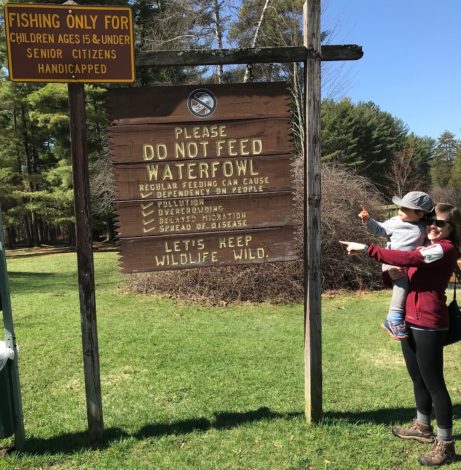


Comments